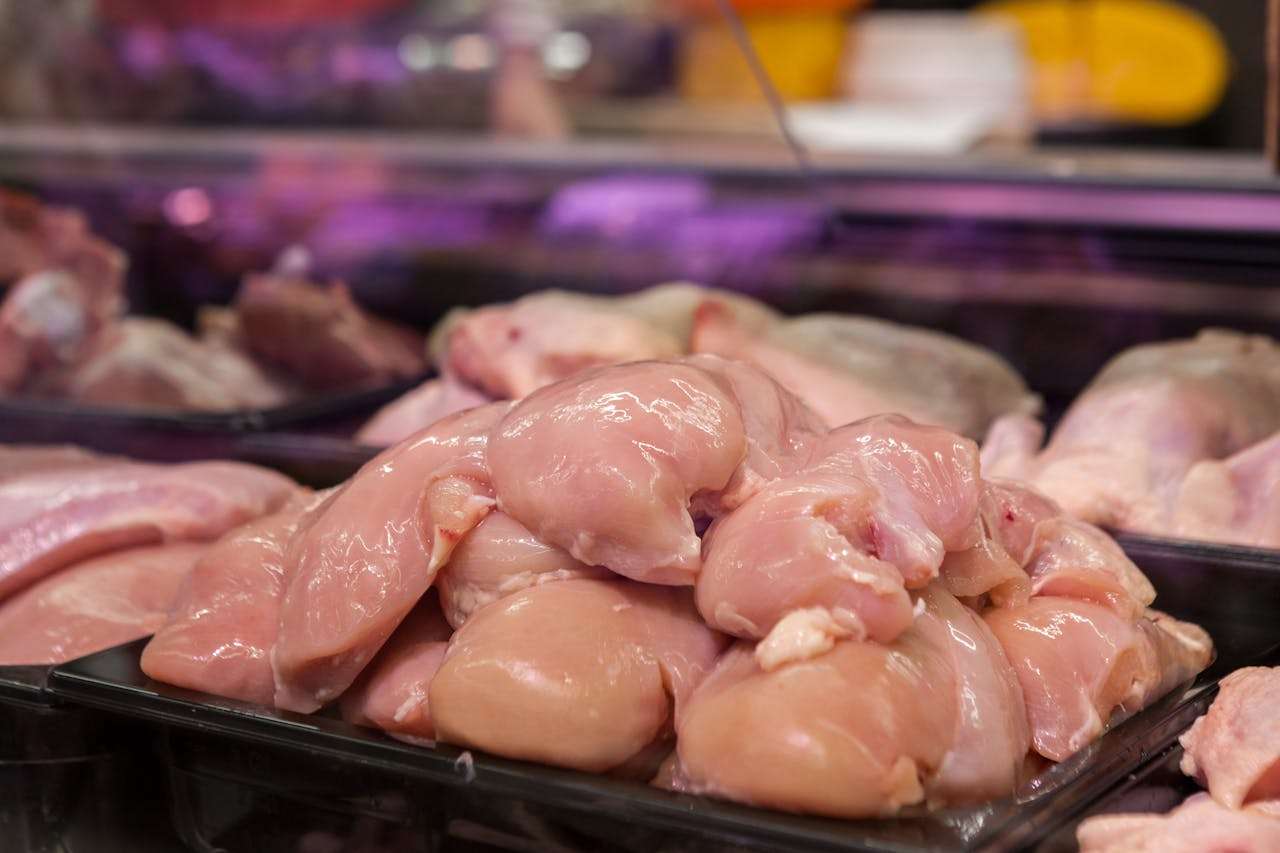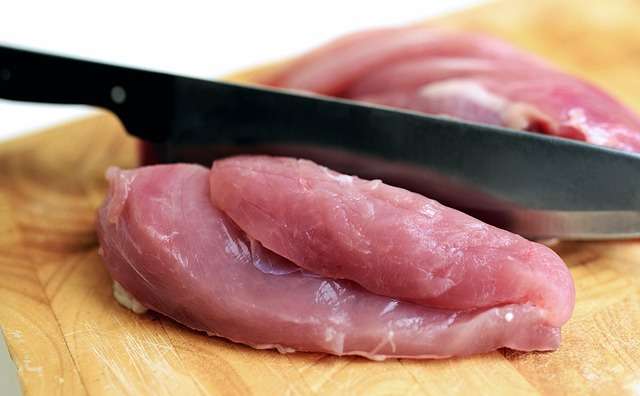Quick Answer: Cats can consume raw chicken, but pet owners should exercise caution due to potential dangers. While raw meat aligns with their carnivorous nature and offers protein and nutrients, it also carries risks, such as Salmonella and E. coli, as well as the potential for bones to splinter. If you choose to feed your cat raw chicken, it should be handled with extreme care, served in moderation, and preferably under veterinary guidance.
Now, let’s explore this topic in detail so you can make the best decision for your feline companion.

Why Do Cat Owners Consider Feeding Raw Chicken?
Because they are obligate carnivores, cats can only meet their nutritional needs through animal protein. This is why some pet parents consider feeding raw chicken:
- Natural diet approach: Mimics what wild cats eat in nature.
- Packed with protein: Promotes muscle maintenance and sustained energy.
- Minimal processing: Unlike some commercial foods.
- BARF (Biologically Appropriate Raw Food) promoters have played a big role in sparking curiosity about raw feeding.
Although the idea sounds appealing, raw feeding involves more than just dropping chicken into a dish.
Nutritional Value of Raw Chicken for Cats
Raw chicken contains essential nutrients that cats need. Here’s a breakdown of what it offers:
Learn more about: Can dogs eat cauliflower
- Protein: Builds muscles, supports tissue repair, and maintains overall body strength.
- Taurine: An essential amino acid for cats (though not always in adequate levels in chicken alone).
- B Vitamins (B6, B12, niacin, riboflavin): Support energy metabolism and nervous system health.
- Phosphorus & Magnesium: Strengthen bones and teeth.
- Iron & Zinc: Help in oxygen transport and immune function.
Comparison Table: Raw Chicken vs. Commercial Cat Food
| Nutrient | Raw Chicken (100g) | Average Commercial Cat Food (100g) |
|---|---|---|
| Protein | 27g | 25–30g |
| Taurine | Moderate | Adequate (supplemented) |
| Fat | 3–6g | 8–12g |
| Carbohydrates | 0g | 10–20g |
| Vitamins/Minerals | Present, variable | Balanced, fortified |
| Safety | Risk of bacteria | Regulated, safer |
👉 While raw chicken is nutrient-rich, it lacks the complete balance that fortified cat food ensures.
Potential Health Benefits of Raw Chicken for Cats
When served correctly, raw chicken may provide:
- Lean protein: Good for weight management.
- Natural chewing exercise: If bones are included (though risky).
- Moisture content: Helps hydration, especially for cats that drink little water.
- Less processed diet: Aligns with a cat’s evolutionary needs.
However, these benefits often come with equal or greater risks.
Risks of Feeding Cats Raw Chicken
Here’s why many veterinarians caution against feeding raw chicken:
Bacterial Infections
- Raw chicken can harbor Salmonella, E. coli, or Campylobacter.
- Cats may get sick, and they can also spread bacteria to humans.
Parasites
Raw meat can carry parasites like Toxoplasma gondii.
Nutritional Imbalance
- Feeding only raw chicken does not provide taurine, calcium, and vitamins in sufficient amounts.
- Long-term deficiency can cause heart problems (dilated cardiomyopathy) or vision loss.
Bone Hazards
Raw bones may splinter, leading to choking, internal injuries, or intestinal blockages.
Food Handling Risks for Humans
Cross-contamination in your kitchen can put your household at risk.
Safe Ways to Offer Raw Chicken to Cats
If you still want to incorporate raw chicken into your cat’s diet, follow these safety practices:
- Consult your veterinarian first: Especially if your cat is very young, senior, or has health issues.
- Choose high-quality, fresh chicken: Ideally human-grade and free from additives.
- Avoid seasoning or marinades: Never feed chicken with salt, garlic, or onion.
- Cut into small, bite-sized pieces: Prevents choking.
- Feed in moderation: Raw chicken should not exceed 10% of your cat’s total diet.
- Practice hygiene: Wash your hands, utensils, and surfaces thoroughly.
Can Kittens Eat Raw Chicken?
Kittens have more sensitive immune systems than adult cats. Feeding them raw chicken increases the risk of:
- Severe bacterial infections
- Nutrient deficiencies during critical growth stages
👉 Answer: It is best not to feed raw chicken to kittens. For balanced growth and development, it’s best to rely on foods formulated for kittens.
Should Cats Eat Raw Chicken Bones?
While raw bones are less brittle than cooked ones, they are still risky:
- Choking hazards
- Internal punctures
- Obstructions in the digestive tract
👉 If you want your cat to have dental benefits, safer alternatives like dental chews or raw meaty bones designed for pets (under vet supervision) are better options.
How Much Raw Chicken Can Cats Eat?
- Raw chicken should only be an occasional treat, not a meal replacement.
- Limit serving to a few small chunks once or twice a week if your vet approves.
- Balance with complete and balanced cat food to avoid nutritional gaps.
Healthy Alternatives to Raw Chicken
If you are hesitant about raw chicken, there are safer protein sources for your cat:
- Cooked chicken: Boiled or baked, no seasoning.
- Turkey or duck: Lean meats with similar nutritional benefits.
- Commercial raw diets: Specially formulated and frozen to reduce bacterial risks.
- High-protein canned food: Provides balanced nutrition and hydration.
Expert Opinion: What Do Vets Recommend?
Most veterinarians recommend:
- Avoid raw chicken unless part of a carefully planned raw diet under professional guidance.
- Using cooked chicken as a safer treat.
- Relying on commercial cat food for complete nutrition.
👉 The key is moderation, balance, and safety.
Final Takeaway
- Cats can eat raw chicken, but the risks often outweigh the benefits.
- Bacteria, bones, and nutritional imbalances are the biggest concerns.
- If you do feed it, keep portions small, ensure top hygiene, and consult your vet.
- Safer options like cooked chicken or commercial cat food provide peace of mind without compromising your cat’s health.
FAQs
Raw chicken carries infection risks despite being digestible.
Yes, but only in small amounts with good hygiene. Do not replace balanced food.
Most cats digest it, but watch for illness and call your vet if symptoms show.
No. Even raw bones pose choking and internal injury risks. Stick to safer dental treats instead.
Yes. Cooked chicken (plain, unseasoned) eliminates bacterial risks while still offering protein.
Yes. Cooked poultry, commercial raw diets, or high-protein canned foods are safer and nutritionally balanced.
Conclusion
Feeding raw chicken to cats sparks debate among pet owners. On one hand, raw chicken offers natural protein and hydration that align with a cat’s carnivorous instincts. On the other hand, it carries substantial risks, including bacterial infections, nutritional imbalances, and potential injury from bones.
The safest approach is to treat raw chicken as an occasional supplement rather than a dietary staple, and only after consulting your veterinarian. Cooked chicken or balanced commercial foods remain far safer choices, ensuring your cat gets complete nutrition without unnecessary health risks.
Ultimately, every cat is unique. What matters most is providing a balanced, safe, and vet-approved diet that supports long-term health, energy, and well-being.


Pingback: Can Cats Eat Carrots? Safety, Benefits & Risks Explained -